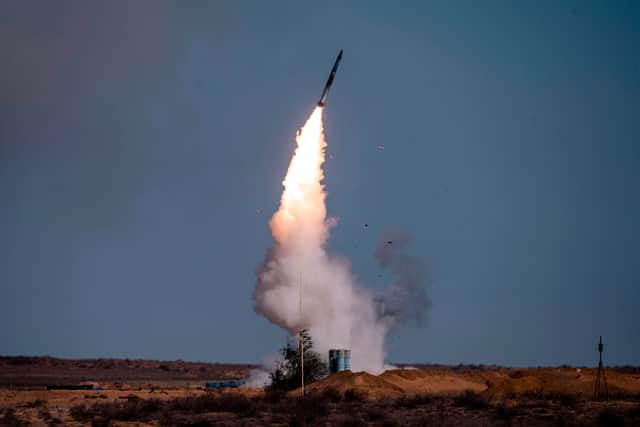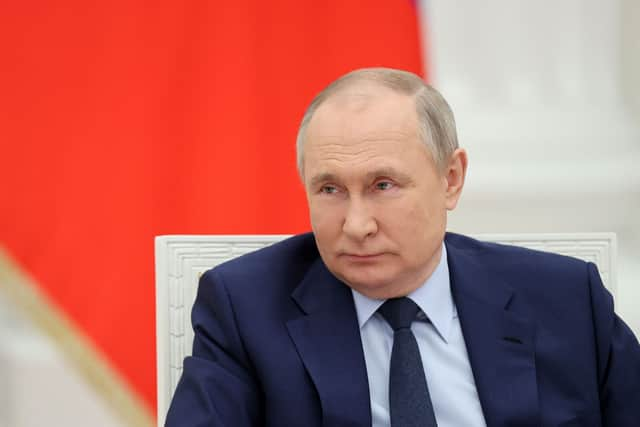Sarmat missile: what is Russia’s intercontinental ballistic weapon dubbed ‘Satan 2’ and what has Putin said?
and live on Freeview channel 276
Russia’s new intercontinental ballistic missile is almost ready for deployment, Vladimir Putin has said.
Speaking in Moscow, Putin vowed to spare no expense when it comes to supporting his military as Russia continues to wage war on Ukraine. He told defence chiefs: “We have no funding restrictions. The country and the government are providing everything that the army asks for.”
Advertisement
Hide AdAdvertisement
Hide AdIt comes seven months after Russia first announced testing of the nuclear-capable ‘Satan II’ Sarmat missile system on 20 April. At the time, Putin boasted that it would be impossible to defend against, claiming the weapon will “make those who, in the heat of frantic, aggressive rhetoric, try to threaten our country, think twice”.
Now, the Russian President has indicated that ‘Satan II’ will be ready in the near future - something which he vowed, without being too specific, will help his country complete all the goals of its invasion of Ukraine. The launch of the Sarmat missile system is a clear example of Russia increasing aggression through its nuclear programme.
But what is the missile, what happened during the test launch, and what exactly did Vladimir Putin say? Here’s what you need to know.


What is Russia’s nuclear-capable ‘Satan II’ missile?
The Sarmat intercontinental ballistic missile (ICBM), called the Sarmat and nicknamed Satan II by some NATO leaders, has been in development for some years with Putin announcing it back in 2018. It replaces the Soviet-era Voyevoda system and is expected to deploy with 10 or more warheads on each missile, according to the US Congressional Research Service.
Advertisement
Hide AdAdvertisement
Hide AdPutin noted the new heavy missile, which has a range of 12,000 miles and soars five times faster than the speed of sound, was made with entirely Russian components - which has been seen as a dig at the current western sanctions. Meanwhile, Dmitry Kiselyov, a man often known as “Putin’s mouthpiece”, claimed that the missile is “capable of destroying an area the size of Texas or England.”
He said in April: “[Their] island is so small that one Sarmat missile is enough to drown it once and for all. A single launch, Boris, and there is no England anymore.”
A month later, in May, Kiselyov called for attacks on Britain with a Poseidon underwater drone that he said would trigger a 1,600ft radioactive tidal wave. The threat was believed to be the result of the UK’s staunch support for Ukraine.
What happened during the test launch?
In April, the Sarmat missile was launched from a facility in Plesetsk, northern Russia, towards a firing range in the Kamchatka Peninsula in the far east. Putin was shown on TV being told by the military that the Sarmat missile had been test-launched for the first time and hit targets nearly 6,000 km (3,700 miles) away.
Advertisement
Hide AdAdvertisement
Hide AdRussian officials notified the US ahead of the test firing, according to the Pentagon, which called the launch “routine” and not a threat to the US.
The Russian defence ministry was quoted by the Interfax news agency as saying: "The launch’s objectives were fully attained. The planned performance specifications were confirmed throughout all phases of the flight."
It added that a regiment of Russia’s Strategic Missile Forces stationed in the Krasnoyarsk territory is being prepared to be armed with the new missile.
What did Putin say at the time?
Putin claimed the missile is virtually impossible to defend against with current technology.
Advertisement
Hide AdAdvertisement
Hide AdDuring a video briefing with defence officials he said: “The new complex has the highest tactical and technical characteristics and is capable of overcoming all modern means of anti-missile defence. It has no analogues in the world and won’t have for a long time to come.”
The test launch of the missile followed Putin’s stark warnings when he started the invasion of Ukraine in February. He warned at the time that any intervention would prompt “such consequences that you have never encountered in your history”, which many took as a nuclear threat.


He subsequently put Russia’s nuclear forces on high alert and used hypersonic missiles in Ukraine, making Russia the first nation to use such weapons in a theatre of war. Hypersonic weapons travel at up to five times the speed of sound, and are more difficult to track and intercept than normal weapons.
What was the reaction to the missile launch?
The Pentagon confirmed that Russia had properly notified it ahead of the test launch of the Sarmat, adding it saw the test as routine and not a threat to the United States.
Advertisement
Hide AdAdvertisement
Hide AdJack Watling, of the RUSI think-tank in London, told Reuters that the test launch was about posturing before the annual Victory Day parade on 9 May, where Russia shows off its latest weaponry. He commented: "The timing of the test reflects the Russians wanting to have something to show as a technological achievement in the lead-up to Victory Day, at a time when a lot of their technology has not delivered the results they would have liked," Watling said.
What has Putin said now?
On 21 December, in an end of year meeting with top defence chiefs, Putin claimed the missile was almost ready for deployment. He also assured his troops that money is no worry for the army, having already laid out a defence budget of $84 billion for the second year of conflict – 40% higher than the initial spending plan announced in 2021.
Comment Guidelines
National World encourages reader discussion on our stories. User feedback, insights and back-and-forth exchanges add a rich layer of context to reporting. Please review our Community Guidelines before commenting.
